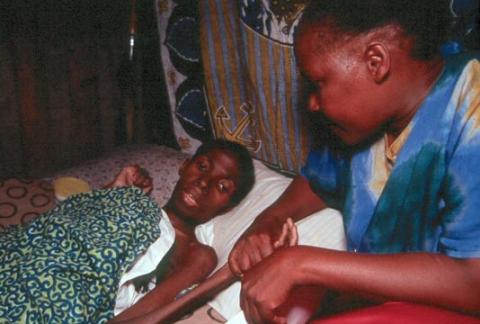
The following reflection was prepared by Susan Gunn, and can be found in A Maryknoll Liturgical Year: Reflections on the Readings for Year B, available from Orbis Books.
In the Africa region, every Maryknoll missioner works with those affected by HIV and AIDS in some way. Maryknoll Father John Sivalon wrote, “I doubt that there is anyone in sub-Saharan Africa who can actually say that they don’t know somebody personally who has been affected by the AIDS epidemic. In Tanzania, Namibia, Kenya, Ethiopia, Sudan, Mozambique and elsewhere, from presidents to peasant farmers, they have all seen either their own children, their nephews and nieces or their neighbors and colleagues’ children die. They have seen their spouses and peers die. And below the surface, for everyone, there is an underlying fear that maybe they also are sick.”
According to the World Health Organization, sub-Saharan Africa contains 10 percent of the world’s population yet approximately 70 percent of those sick with HIV and AIDS. There is great suffering and great need for healing.
Today’s Gospel from Mark tells of the miracle of Jesus healing the deaf and mute man. The man is brought to Jesus by his community who implores Jesus to heal him. Jesus takes the man aside and uses four simple gestures as a sort of sign language to communicate what he plans to do. This alone is remarkable since the common perception of the time, and maybe even still in some places today, is that deaf and mute people lack intelligence or even sanity, since they cannot articulate their thoughts through speech. Jesus demonstrates right behavior for us to follow: treat all people with love and respect and compassion, even if they are different from us.
The four simple gestures that Jesus used also demonstrate a pattern for ministry. Each gesture represents part of the healing miracle. First, Jesus touched the man’s ears to acknowledge the situation. Jesus shows us the importance of touch to establish a contact for healing even when his words alone would have sufficed. We cannot convey the love of Christ for all people without touching them in some way. This can mean literally touching a person, especially a person who is physically distressed. In the early years of the AIDS epidemic, many people were afraid to even touch the skin of a HIV-positive person despite knowing that the virus cannot be transmitted this way. Jesus did not literally touch each person he met, but he did make a point to reach out and touch people who were considered untouchable, such as lepers and a deaf and mute man who many may have judged to be insane because of his inability to communicate.
The second gesture Jesus used was to put his spittle on the deaf and mute man’s tongue. Now, Maryknollers are not rubbing their spittle on HIV and AIDS patients in Africa. They are using other therapeutic measures to ease suffering and promote healing. In the book My Own Country, Dr. Abraham Verghese shares his experience as the infectious disease doctor in a small city in Tennessee during the early years of the AIDS epidemic. He writes that one nurse said to him what many were thinking: “Why should we help them? They’re all going to die anyway.” We all are going to die anyway. This fact does not negate the value of easing suffering and promoting healing. Advances in medicine and in understanding of how HIV is transmitted have improved the life-expectancy of HIV-positive people as well as the quality of life for them and their families. We pray that more medical research leads to finding a cure for this awful disease.
The third gesture is a gesture of prayer. Jesus looks to heaven. Jesus’ work is attributed to God. His healing power comes from God, who does “everything well” starting with creation. The miracle of opening the deaf man’s blocked ears represents the restoration of blocked communication between God and humanity through Jesus. He is God’s intervention in human history.
The fourth and final gesture is the deep sigh Jesus felt when he looked to heaven. The sigh is the gesture of receiving God’s power to perform this miracle. By receiving it, Jesus can then speak the authoritative word “Ephphatha!” demanding that the man’s ears be open. The actual healing comes from the word. When the deaf and mute man could hear and speak, the people realized that there is a compassionate power from heaven that changed his life.
Jesus asked the deaf man and the other people there not to speak about the miracle because the messianic message was not complete yet. We know the whole message: there is a compassionate power from heaven that can change the world, a creator who does all things well, and a cross and Resurrection that set us free from sin. We, along with Maryknoll missioners, pray for a healing miracle for people with HIV and AIDS. We prayerfully offer ourselves to be a part of that healing miracle. We give thanks for the Maryknoll missioners who are touching the lives of those suffering with HIV and AIDS in Africa. We look to heaven for God’s guidance and we remain open to receiving the word!
